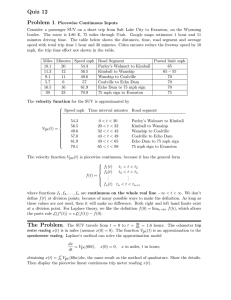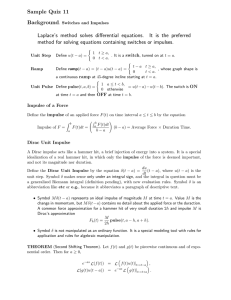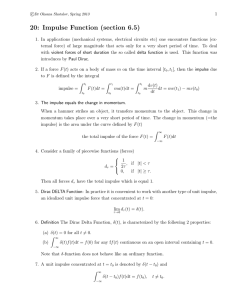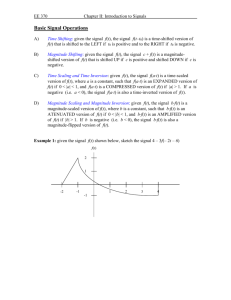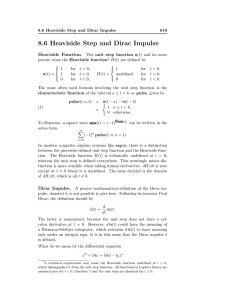Quiz 11 Background for solving equations containing switches or impulses.
advertisement
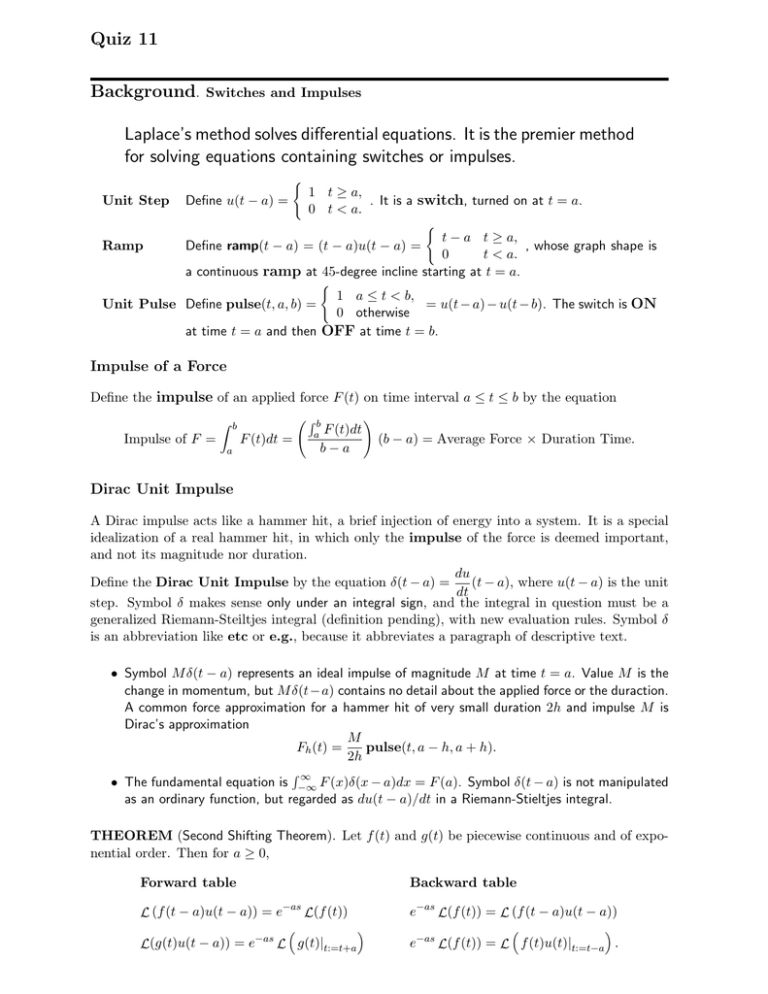
Quiz 11
Background.
Switches and Impulses
Laplace’s method solves differential equations. It is the premier method
for solving equations containing switches or impulses.
(
Unit Step
Define u(t − a) =
1 t ≥ a,
. It is a switch, turned on at t = a.
0 t < a.
(
Ramp
t − a t ≥ a,
, whose graph shape is
0
t < a.
a continuous ramp at 45-degree incline starting at t = a.
Define ramp(t − a) = (t − a)u(t − a) =
(
1 a ≤ t < b,
= u(t − a) − u(t − b). The switch is ON
0 otherwise
at time t = a and then OFF at time t = b.
Unit Pulse Define pulse(t, a, b) =
Impulse of a Force
Define the impulse of an applied force F (t) on time interval a ≤ t ≤ b by the equation
Rb
Z b
F (t)dt =
Impulse of F =
a
a
F (t)dt
b−a
!
(b − a) = Average Force × Duration Time.
Dirac Unit Impulse
A Dirac impulse acts like a hammer hit, a brief injection of energy into a system. It is a special
idealization of a real hammer hit, in which only the impulse of the force is deemed important,
and not its magnitude nor duration.
du
Define the Dirac Unit Impulse by the equation δ(t − a) =
(t − a), where u(t − a) is the unit
dt
step. Symbol δ makes sense only under an integral sign, and the integral in question must be a
generalized Riemann-Steiltjes integral (definition pending), with new evaluation rules. Symbol δ
is an abbreviation like etc or e.g., because it abbreviates a paragraph of descriptive text.
• Symbol M δ(t − a) represents an ideal impulse of magnitude M at time t = a. Value M is the
change in momentum, but M δ(t−a) contains no detail about the applied force or the duraction.
A common force approximation for a hammer hit of very small duration 2h and impulse M is
Dirac’s approximation
M
Fh (t) =
pulse(t, a − h, a + h).
2h
∞
• The fundamental equation is −∞
F (x)δ(x − a)dx = F (a). Symbol δ(t − a) is not manipulated
as an ordinary function, but regarded as du(t − a)/dt in a Riemann-Stieltjes integral.
R
THEOREM (Second Shifting Theorem). Let f (t) and g(t) be piecewise continuous and of exponential order. Then for a ≥ 0,
Forward table
Backward table
−as
L (f (t − a)u(t − a)) = e
e−as L(f (t)) = L (f (t − a)u(t − a))
L(f (t))
−as
L(g(t)u(t − a)) = e
L g(t)|t:=t+a
e−as L(f (t)) = L f (t)u(t)|t:=t−a .
Problem 1.
Solve the following by Laplace methods.
(a) Forward table. Compute the Laplace integral for terms involving the unit step, ramp and
pulse, in these special cases:
(1) L((t − 1)u(t − 1))
(2) L(et ramp(t − 2)),
(3) L(5 pulse(t, 2, 4)).
(b) Backward table. Find f (t) in the following special cases.
(1) L(f ) =
e−2s
s
(2) L(f ) =
e−s
(s + 1)2
3
3
(3) L(f ) = e−s − e−2s .
s
s
Problem 2.
Solve the following Dirac impulse problem.
(c) Dirac Impulse and the Second Shifting theorem. Solve the following forward table problems.
(1) L(2δ(t − 5)),
(2) L(2δ(t − 1) + 5δ(t − 3)),
(3) L(et δ(t − 2)).
The sum of Dirac impulses in (2) is called an impulse train. The numbers 2 and 5 represent
the applied impulse at times 1 and 3, respectively.
Reference: The Riemann-Stieltjes Integral
Definition
The Riemann-Stieltjes integral of a real-valued function f of a real variable with respect to a real
monotone non-decreasing function g is denoted by
Z b
f (x) dg(x)
a
and defined to be the limit, as the mesh of the partition
P = {a = x0 < x1 < · · · < xn = b}
of the interval [a, b] approaches zero, of the approximating RiemannStieltjes sum
S(P, f, g) =
n−1
X
f (ci )(g(xi+1 ) − g(xi ))
i=0
where ci is in the i-th subinterval [xi , xi+1 ]. The two functions f and g are respectively called the
integrand and the integrator.
The limit is a number A, the value of the Riemann-Stieltjes integral. The meaning of the limit:
Given ε > 0, then there exists δ > 0 such that for every partition P = {a = x0 < x1 < · · · < xn =
b} with mesh(P ) = max 0≤i<n (xi+1 − xi ) < δ, and for every choice of points ci in [xi , xi+1 ],
|S(P, f, g) − A| < ε.
